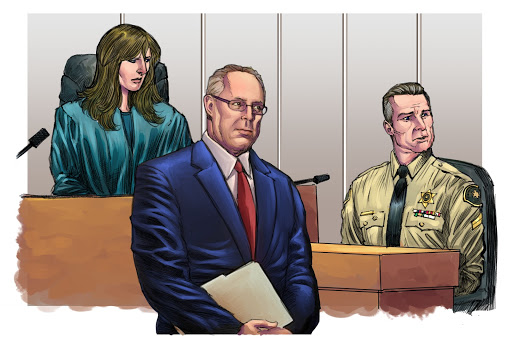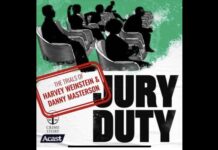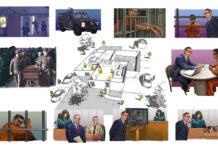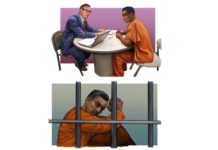On today’s podcast we present Part 8 of Mongol, our exclusive new Crime Story series written and read by Molly Miller that tells the story of the tragic killing of a police officer and the complex search for truth and justice in the aftermath of his death. You can find all of the previously published parts of the series here.

Part 8
When Brady Sullivan and his second chair, Barbara Martin, arrived for opening statements, they were met with a sea of law enforcement in the gallery. A dozen officers in grey suits sat by Shaun Diamond’s daughter, Margo. The jury couldn’t help glancing in their direction. The Martinez family was also present, seated in the left side of the gallery. They held hands and whispered prayers under their breath. David’s parents stood firm in their belief that their son never shot Shaun Diamond. To them, this whole trial was founded on a fabrication by the police.
In the prosecution’s opening Deputy District Attorney Michael Blake portrayed David as a violent gang member who “saw his opportunity and took his shot.” Sullivan followed Blake’s blunt assessment with a more nuanced version of events. Pacing before the jury, Sullivan explained that the evening of October 28, 2014 was a “perfect storm” in which a series of unexpected circumstances came together and resulted in tragedy. But Sullivan asserted that amidst that storm his client had acted in self defense: he shot to protect his family.
The arguments that followed kicked off with a long procession of police in full uniform. For three weeks, officers took the stand. Under Jack Garden’s guiding hand, their testimonies reinforced the narrative that the SWAT team followed procedure and announced their presence at the Martinez home. No rifles were pointed at the doorway. Martinez had ample warning that the police were at his door. He fired his weapon and the bullet struck a fine young officer who was just doing his job.
Each of the officers was a new battle for Sullivan, another opportunity for him to unravel the prosecution’s narrative. How loud was the sound of the ripram hitting the gate? How many times did you announce yourself? Why wasn’t there an officer stationed in the backyard? His inquiries were effective, but they were undermined by constant objections — leading, asked and answered, improper hypothetical, misstates the evidence. Judge Charlaine Olmedo sustained nearly every objection, impeding the momentum that Sullivan gained.
A stand out in the series of officers was Jim Moss, the SWAT paramedic who treated Shaun Diamond immediately after he was shot. Moss described the bloody trauma to Diamond’s airway, his words seeped in loss as he made eye contact with every juror. There was a clear conclusion that Jack Garden intended for the jury to draw — Diamond died a horrible, painful death. The shooter should pay for that.
In the wake of the emotional testimony, Sullivan cross-examined Moss with dogged persistence, causing him to concede that the police announcements were made by multiple voices that sometimes overlapped. This allowed Sullivan to suggest that the cacophony of shouts and banging might have been unintelligible to the inhabitants of the house at 3:30 am. David might not have heard the police announce themselves at all. Then Sullivan focused on what Moss saw during the operation. That evening Jim Moss had been positioned behind a Mustang in a neighbor’s driveway. From his vantage point he could see into the house through the living room window. Sullivan prompted Moss to admit that after the announcements started he saw a man inside the house walk towards the door. Moss tried to alert the other officers that someone was coming but his voice was drowned out by the banging and the shouting and barking of Martinez’s dogs. If Moss’ message had been heard, then the SWAT team may have waited for Arturo to open the door. And if they waited, maybe David wouldn’t have felt the need to defend his family with his shotgun. If the chaos of the scene really was the “perfect storm” then Jim Moss’ testimony was evidence of the thunder and the lightning.
Sullivan’s cross examination of Moss was a victory, but Sullivan wasn’t slowing down. His confidence grew as Officer Jaime Martinez took the stand. Jaime Martinez was part of the SWAT team on the porch the night of the shooting. He was the assigned “first man.” After Sergeant Aguiar and Officer Diamond breached the metal security door with the ripram, he was supposed to be the first officer to enter the household. Until then, his job was to use his rifle to cover the window — protecting the team from potential threats inside the home. Jack Garden tossed Jaime Martinez a question. “Prior to the gunshot from inside the house, did you ever poke your gun into the house?” It was a softball. An easy no. Of course Jaime never poked his gun into the house. It would have been impossible from where he was standing. Jaime Martinez casually responded, “Yes, I pointed my weapon into the house.” Garden quickly reoriented the question. His eyes flashing with something that looked like nerves. “Not point . Did you ever poke it into the house?” Jaime Martinez shook his head, but the damage was done. Sullivan had now identified the gun that was pointed at the door. The gun that Martinez saw that made him fear for his life. The gun that merited his client’s claim of self-defense.
But then the seas changed as Darrin Kozlowski approached the stand. Bearded and brawny, Kozlowski was a former ATF agent who infiltrated the Mongols from 2005- 2008, during which time he went by the moniker of “Dirty Dan.” He described the Mongols’ illegal activities in great detail as well as their hatred of law enforcement. Lifting Martinez’s motorcycle jacket from a cardboard evidence box, Kozlowski testified regarding every patch on the leather garment. The rocker and back patch meant Martinez was a full member. His 1% badge meant he considered himself an outlaw. His “Respect Few Fear None” patch meant that he assaulted a rival gang member. The prosecution also pointed to the fact that the President of the Mongols Motorcycle Club and several other high ranking members put money on Martinez’s books while he was in jail. Every stitch of association between Martinez and the Mongols knit a narrative that Martinez was a gang member, a criminal, and a killer. Sullivan knew the danger of that story; he needed to unravel it to convince the jury of Martinez’s innocence. But the prosecution was not done sewing.
Jack Garden called Sandra Roman to the stand. David Martinez struggled to contain his emotions as he watched his wife raise her right hand to take her oath. Sandra didn’t want to testify but because she and David didn’t have a marriage license, their relationship was only considered a common law marriage. Marital privileges did not
apply. Sandra testified for hours regarding Martinez’s involvement in the Mongols Motorcycle Club. Her responses were tearful and often terse, prompting the court to allow Jack Garden to treat her as a hostile witness. But Sandra’s one word answers and defiant attitude didn’t deter the prosecution. Garden proceeded to display twenty-six articles of evidence taken from Sandra and David Martinez’s bedroom: plaques, party fliers, vests, belts, and T-shirts. There were pictures of Martinez in Mongols clothes and photos of David arm in arm with Mongols’ President, Little Dave. Sandra was cornered. She admitted Martinez owned the items and that he had been involved with the brotherhood for over three years. According to Sandra, David Martinez loved his Mongol “brothers.” She told the court that Martinez’ association with the Mongols upset her. She didn’t like that the club made him pay dues and encouraged him to spend weekends partying away from his family. Garden nodded at Sandra’s explanation.
Then he took his questions one step further. “He would go out with them and he would smoke meth with them. Is that right?” Sandra hesitated, delicate in her response. She recalled that Martinez told her that he was struggling with meth addiction three weeks prior to the incident. He was getting ahead of work so that he could spend time in treatment. They had already visited the hospital where Martinez planned to
be admitted. Garden paced by the jury box and inquired about the night of Officer Diamond’s death. “And on the night or morning when you saw him in the office he was high on methamphetamine, correct?” Sandra responded quietly. “I assume so. Yes.” She recounted that Martinez was hyperactive and sweating. And it wasn’t usual for him to be up at 3am. When Sandra stepped down, David gave her a small smile as he folded and unfolded scraps of paper on the counsel’s table.
It had taken weeks for the prosecutors to paint David Martinez as a hardened gang member but now the portrait was vivid. The defendant once shrouded in innocence now looked the part of a criminal drug user who might shoot a cop for bragging rights. Martinez’s worried glance at Sullivan betrayed his fear. How could a jury believe the word of a Mongol over the testimony of officers? Sullivan reassured him.
The public defender had a plan and he wasn’t going down without a fight.





